Rabindranath Tagore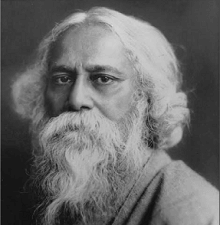
Rabindranath Tagore, a multitalented personality, can be explained as "here is god's plenty." He was a poet, a novelist, a painter, a social reformer, a composer, a philosopher, etc., and was also known as Gurudev. Although his first language was Bengali, he started his writings in Bengali but later translated many of them into English, which became the milestone of his literary career. However, he has written so many poems, short stories, novels, dramas, etc., but his fame mainly lies in 'Gitanjali' and the national anthem 'Jana Gana Mana'. He also wrote the national anthem for Bangladesh, 'Amar Shonar Bangla'. Tagore's work also inspired the national anthem of Sri Lanka. Tagore's GreatnessRabindranath Tagore was one of the great personalities in the history of Indian English and Bengali literature. His contribution to emerging Indian English or Bengali literature is significant and remarkable. However, Tagore did not have academic struggles due to improper schooling. His conscious mind and ability to penetrate or understand nature and the life around him made him a great literary figure. He was the first Indian to get the Novel Prize for literature in 1913 and gained a place for modern India on the world literary scene. Even this Novel Prize in Literature award was just the beginning of his global recognition for the place very few can attain in literary history. He got the Novel Prize for his most popular collection of poems, 'Gitanjali'. He also influenced many great English poets like Ezra Pound and W.B. Yeats. His greatness lies in music and poetry; his songs are sung everywhere, wherever Bengali is spoken. He was a great man who left behind a great institution of Vishva Bharti at Shantiniketan. Tagore's Life and EventsEarly life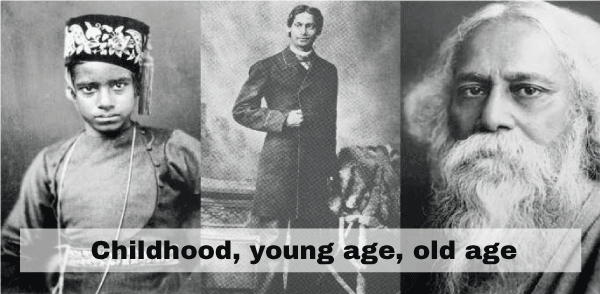
Rabindranath Tagore was born on 6th May 1861 in Jorasanko Mansion, Calcutta. His father was Maharshi Debendranath Tagore, and his mother was Sarada Devi. It was a coincidence that Tagore and Motilal Nehru (father of Jawaharlal Nehru) were born on the same date. He was the youngest of seven siblings. Due to Tagore's mother dying in his early childhood, servants brought him up. Rabindranath Tagore, earlier known as Robindronath Thakur (nickname Rabi), was a Rarhi Brahmin with his original title Kushari. His village is Kush, located in Burdwan district West Bengal. Both his grandfather (Prince Dwarakanath) and his father had a strong social background as his grandfather was a friend of Raja Rammohan Roy, and his father was a big supporter as well as the strength of Brahmo Samaj in its palmy days. Art and literature were rooted in his family background. His family was the publisher of literary magazines, and they were active in theatre and fond of classical music. Even Tagore's father employed musicians to teach classical music to his children. Tagore's siblings were also full of literary minds as his brothers, like Dwijendranath, were a philosopher and a poet, Jyotirindranath was a musician, composer, and playwright, and Swarnakumari (sister) was a novelist. His one brother named, Satyendranath, was the 1st Indian appointed as an all-European Indian civil service. Swarnakumari, his sister, went on to publish novels. The wife of Jyotirindranath, Kadambari Devi, a little older than Tagore, was a close companion and a significant force. He was deeply saddened by her sudden suicide in 1884, just a few months after their marriage. Tagore mainly shunned formal education and preferred to explore the manor or the adjacent Bolpur and Panihati, which the family would travel to. His brother Hemendranath tutored and kept him in shape by having him swim in the Ganges or go up hills, practice judo and wrestling, and practice gymnastics. He studied Sanskrit, mathematics, sketching, anatomy, geography, and English, his least favored subject. Tagore detested conventional schooling; he spent just one day struggling through classes at the neighborhood Presidency College. Years later, he believed that good instruction fosters curiosity rather than attempting to explain things. Tagore's Traveling and His Early WritingLike Shakespeare, Tagore had very little schooling, and he learned more from his traveling, nature, society, and the lives of human beings. After getting to the age of 11 and after his upanayana sanskar in 1873, he first visited Santiniketan and went to Dalhousie with his father. There he read the biographies, history, astronomy, science, Sanskrit, and the poetry of Kalidas and other poets variously. While traveling, he visited Amritsar, where he was influenced by the songs of Gurunanak Bani in the Golden Temple. Later he mentioned these experiences in his autobiography My Reminiscences (1912). Tagore began his writing at an early stage when he was 15 years old. In 1875 his first publication came that was in prose and verse. Before attaining his 18, he wrote about 7000 lines in verse. His first short story, originally written in Bengali, was "Bhikharini" Later, it was translated into English as "The Beggar Woman." That time, he got inspiration from Bengali Vaishnava singers and Indian devotional poetry. Ancient Indian text like the Vedas, the Upanishads, the Puranas, Ramayana, and Mahabharata was the source of inspiration for Tagore as their influence can be seen upon him. The Indian saints like Guru Nanak and Kabir also influenced him. Tagore's London lifeRabindranath Tagore's time in London was a significant period in his life and profoundly influenced his artistic and intellectual development. Despite Tagore's interest in literature, his father wanted his son to become a barrister. In 1878, he was admitted to a public school in Brighton, London. But after a very short period, he left school and started an independent study. He studied Shakespeare's plays and Thomas Browne's Religio Medici, which influenced him the most. He also read romantics and Victorian poets who inspired him the most. They were Wordsworth, Keats, Shelley, Tennyson, and Browning. Tagore performed his literary works, gave lectures, and attended conferences in London. He discussed his views on Indian spirituality, culture, and the necessity of cross-cultural dialogue. The intellectual and artistic world paid close attention to Tagore's visit to London and were pleased with his lectures. Tagore concentrated on translating his works into English while he was in London. He sought to bridge the cultural divide between India and the West by making his poems and writings available to a larger audience. His translation work was crucial in popularising his writing among English-speaking audiences and establishing his standing as a poet and philosopher on a global scale. Like his overall life, Tagore's time in London was characterized by his ability to bridge cultures, break conventional boundaries, and foster meaningful connections. His interactions and experiences in London left an indelible mark on his artistic and intellectual legacy, and his contributions continue to be celebrated in India and worldwide. Tagore's Marriage Life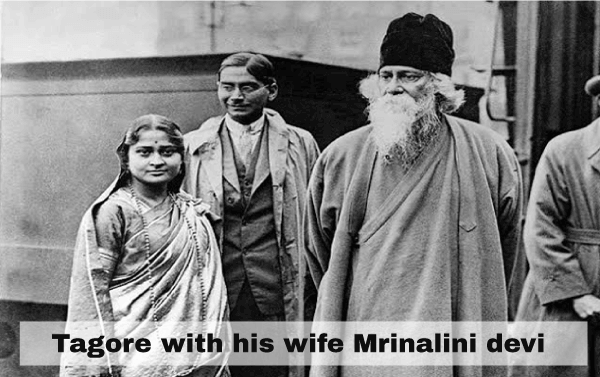
In 1880 Tagore returned to Bengal and had been publishing his poems, novels and short stories regularly. Tagore married in 1883 to Mrinalini Devi, who was just 10 years old then. Later they had five children, but only three of them could survive. As Tagore's literary and intellectual pursuits expanded, he traveled extensively and spent considerable time away from his family. This physical distance and preoccupation with his work impacted his relationship with Mrinalini. Despite this, Tagore maintained a cordial and respectful bond with his wife throughout their lives. It's important to note that Tagore's ideas on love and relationships went beyond societal norms. He believed in the power of emotional and intellectual connection rather than conventional obligations. Tagore experienced profound connections with several women throughout his life, some considered controversial. One of the most special relationships in Tagore's life was with his niece, Indira Devi, known as "Nashtanir" in his writings. Their relationship was not a conventional romantic but carried emotional intensity and intellectual companionship. Tagore wrote about this complex relationship in his novella "Nashtanir" (The Broken Home) and later adapted it into a movie called "Charulata." Despite these emotional and intellectual connections outside his marriage, Tagore remained married to Mrinalini until he died in 1941. While his marriage was unconventional and marked by physical and emotional distances, it is essential to understand it within the context of the societal norms and cultural practices prevalent during that time. The period of 1891-95 is known as the Sadhana period of Tagore's life. These years are the most productive as he wrote most of the stories of the three volumes of "Galpaguchchha" (84 stories). In these stories, he portrayed rural Bengal's pathetic condition and poverty. In 1998 Tagore joined his family in ancestral estates in Shelaidaha (now part of Bangladesh). There Tagore owned a boat named Padma, also known as Budgerow. It was a luxurious family barge. 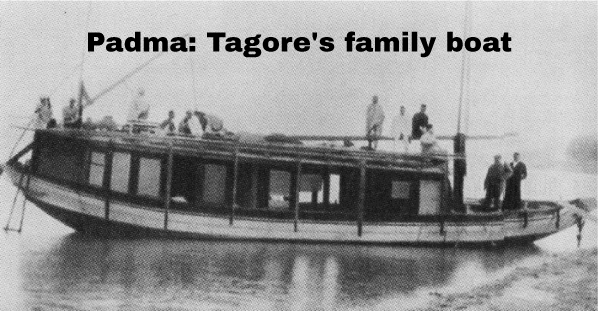
Foundation of Visva Bharti SantiniketanFurther, Tagore shifted to Santiniketan in 1901 and founded an ashram. His wife died in 1902, and his two children died there. His father also died in 1905. Tagore was against classroom schooling. According to him, classroom schooling is a parrot's training, where a bird is caged and force-fed textbook pages to death. When he visited Santa Barbara in 1917, he got the idea of a new teaching method. He founded Visva Bharti in 1918, although it was inaugurated three years later. The school had a brahmacharya system, and the gurus used it to guide their students (emotional, intellectual, and spiritual). The teaching was done under the trees. Tagore contributed his Nobel Prize money to Santiniketan. He used to teach the students as well as used to write textbooks for students. He made Santiniketan a bridge connecting India and the world and a center for studying humanity. He fundraised for the school in Europe and the USA. 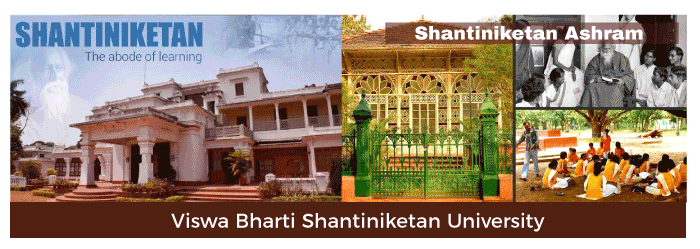
Establishment of ShriniketanIn 1921 Shriniketan (abode of welfare) was established by Tagore and Leonard Elmhurst (agricultural economist) in Sural village. Through this institute, Tagore strengthens Gandhi's Swaraj protest against the British. He also lectured against caste discrimination and untouchability. He opened the Guruvayoor temple for Dalits. Tagore's Later Years and His Foreign TourIn later years Tagore visited many countries. He was an unofficial ambassador of India because only his presence and speech were used to increase the prestige of India. However, his involvement was not in politics, but he had good and friendly relations with Mahatma Gandhi and Jawaharlal Nehru. Gradually with time, he became more influential as well as a legendary figure. Tagore's Last Years and DeathIn his last five years, he suffered from chronic pain and a long illness and died on 7th August 1941 at the age of 80 in the room of Jorasanko Mansion where he had grown up. In the words of Dr. Edward Thompson, "not a man only but an age had made its way at last into history. He had summed up in himself as a whole age, in which India moved into the modern world". Tagore's awardsTagore received many awards. In 1913 he got the Nobel Prize in Literature. In 1915 he got a knighthood honor from King George V but renounced the award after the Jallianwala Bagh massacre in 1919. Later in March 2004, the Nobel Prize was stolen from Visva-Bharti, and the same year in December, two replicas of the Nobel Prize, one of gold and another of bronze, were presented by Swedish Academy. However, in 2016 the shelter of thieves was caught, and the prize was recovered. Tagore's Source of IncomeHis sources of income were book royalties (2000 rupees), monthly payments from Shantiniketan as part of his inheritance, and from the maharaja of Tripura as he sold the Jewellery of his family and from his bungalow of Puri. According to Bengalis critics, Tagore is the greatest writer. He left behind him a bulk of writings in all genres like poetry, prose both in Bengali and English translation, novels (3 full novels), and short stories which 50 short stories were translated into English, several lectures, essays on various topics, letters, and plays. However, he had written in all genres but was top in his poetry. Tagore as a PoetHis greatest collection of poems, Gitanjali, consists of 100 poems. He expressed his thoughts and feelings about man, god and nature in the songs of Gitanjali. These songs are mainly poems of devotion to god. Devotional poetry occupies a very important place in the Indian tradition. Those who write it can never be proud or arrogant. They can never think that they are superior to others. The songs in 'Gitanjali' are the best examples of devotional poetry in the modern age. These songs are the poet's meditation on the relationship between god, human beings, and nature. They are also called bhakti and mystical poems. W.B Yeats says in his essay on Gitanjali, "I read Rabindranath every day; to read one line of his is to forget all the troubles of the world". Some poems of 'Gitanjali' are; Heaven of Freedom, this poem is in the coursebook of schools and colleges where the students used to recite it. Another poem is The Cresent Moon; it is a child poem. In this poem, Tagore describes the beauty, innocence, humour and all mystic quality of a child. In this poem, Tagore portrays the thought and feelings of a child. In another poem, The Bhagavata, he explains the childhood stage of Krishna. In this poem, superior, he explains the older child. Tagore's Authorship is a poem of fancy. In the poem The Last Bargain, a child wins because the king with his power, the rich man with his money, and the fair maid with her beauty all looses because they cannot hire the poet. Love occupies a very important place in the poetry of Rabindranath Tagore. The borderline between human love and the love of god becomes indistinct on many occasions in his poetry. The loss of distinction charms the readers. The devotion to god expresses itself in love for him on many occasions. 'The Gardner' is a very important collection of love poems by Rabindranath Tagore. After Gitanjali, the Gardner consists of large collections of poetry. They are also love poems like Gitanjali but the love for human beings, not for divine power. List of Tagore's Poetry in Bengali with English-Translated Names
Some facts about Tagore that make him a great poet are:
Tagore as a NovelistIf we talk about the novel and short stories of Rabindranath Tagore, we can say that he was a novelist of ideas. The following lines of Ralph Fox suited to the Tagore: "The novelist, therefore, has a special responsibility to the present and the past of his country. What he inherits from the past is important because it shows the sections of his country's cultural heritage which have meaning today. What he says of the present is important because he is assumed to be expressing what is most vital in the spirit of his time. It may be objected that the novelist is not concerned with other people's attitudes to his work. What he inherits, what he expresses is strictly his affair." Names of Tagore Fiction in Bengali and Their English Translations
Tagore, all the novels were written in Bengali, but three novels, The Wreck (1921), Gora (1923) and The Home and the World (1919), were translated into English. We can trace a spirit of humanism and universalism in his novels as there is an influence of ancient grantha like Upnishadas on it. Due to his deep consciousness, he was well aware of his surrounding as well as the problems of mankind. He had deep sympathy for the poor and downtrodden. His novels are social novel which portrays the problems of human life. Like in The Wreck, he portrays the problems of marriage. The novel is full of uncertainty and chances. Two marriage parties were sailing on a boat. Unfortunately, the boat is drowned, and only two people on the boat could be saved. They are Kamala, one of the brides, and Ramesh, one of the bridegrooms. However, in the end, Kamala meets his husband, and the story ends happily. Gora is a political novel. In this novel, Tagore conveyed his vision about an individual's role in British India through the protagonist of the novel Gora. At the start of the novel, Gora is presented as a Hindu patriot who rebels against the exploitation and injustice of British rule. He follows Hinduism so blindly that he accepts all its orthodox and superstitious traditions. For example, he breaks his relations with his friend by marrying him to an inter-caste girl. But by the end of the novel, when the truth reveals about his birth and his birth parents, he realizes that human love is the greatest religion. He enlightens and gets free from all shackles and says: That which day and night I have been longing for, but which I could not be, today, at last, I have become. Today I am an Indian! In me, there is no longer any opposition between Hinduism, Musalman, and Christianity. Today every cast in India is my cast. The Home and the World is also a political novel. Through this novel, Tagore portrays the different ways of freedom fighters for the independence of the country and, by the end, also suggests the right way. The novel revolves around three characters Bimla, Sandip and Nikhil. Nikhil adopts the non-violence way for the freedom struggle, and Sandip follows the violent way. Bimala, who is the wife of Nikhil first influenced by Sandip's ways of freedom struggle and also develops relations with him. But finally, she comes back and accepts the non-violence way of her husband, Nikhil. In this novel, Tagore conveys the method of non-violence is the right way that every Indian should follow in their struggle for independence. Tagore's Short StoriesApart from these novels, Tagore has also written many short stories. His short stories are considered the best stories in world literature. Tagore conveys in the short stories the pathos, beauty, and sublimity of life through the simple characters and incidents of human life. He portrayed love, human relationship, supernatural things, and the relation between man and nature. In his story 'Cabuliwallah,' he shows the affection of a father for his daughter. Homecoming is a tragic story of Phatik, who, after going to Calcutta, always remember his home and wants to come back. There is a feeling of nostalgia. He could not escape from this feeling and finally fell ill, which proved fatal. In the story The Night and the Skeleton, he portrays supernatural suggestions. He portrays the social problems in My Fair Neighbor, in which he exposes the cast system; in Babus of Nayanjore, he portrays the family fights; and in The Wife's Letter, he discloses the modern woman. He portrays romance in his story The Hungry Stone and Victory. So overall, Tagore wrote short stories in a different area that influenced the development of the Indian English novel. His novels, as well as short stories, are social and realistic. Through these writings, Tagore exposes the evils and drawbacks of society and, at the same time, also gives suggestions about a man or society and how these should be. Names of Tagore's Dramas in Bengali with English Translated Name
Tagore wrote only one book originally in English, Thought Relics (1921). All his other books are translations. Tagore's Biographies in Bengali and their English Translation
List of Tagore's English Translations with Publishing Year
So many movies and serials are made on Tagore's novels and short stories in both Bengali and Hindi. Some of his Bengali movies are:
Some Hindi movies and serials are:
Apart from these, several Bengali movies were made on Rabindranath Tagore; in 1961, Satyajit Ray wrote and directed the film Rabindranath Tagore. In 2002 Tagore was portrayed by Jisshu Sengupta in the movie Chhelebela. In 2007 Sayandip Bhattacharya played the role of Tagore in the movie Chirosakha He. In 2011 Samadarshi Dutta played the role of Tagore in the movie Jeevan Smiriti. In 2015 Parambrata Chatterjee portrayed Tagore in the movie Kadambari. ConclusionRabindranath Tagore loved India, and he loved the whole world. He thought Bengal to be a beautiful part of India and the whole of India to be a beautiful part of the world. In the words of K.R Srinivasan Iyengar, Rabindranath Tagore was essentially an internationalist. He interpreted the heart of India to the whole world, and this heart of India had only love for the entire humanity.
Next TopicNelson Mandela
|
 For Videos Join Our Youtube Channel: Join Now
For Videos Join Our Youtube Channel: Join Now
Feedback
- Send your Feedback to [email protected]
Help Others, Please Share










